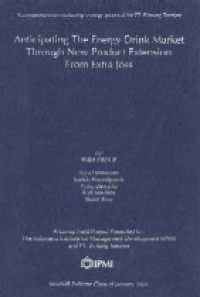
Influence of Market Risk on Capital and Performance of PT. Bank Negera Indonesia (Persero) Tbk
| Gmd : Text
| Availability :
| 00000010690 | 317 | (GFP) | Available - Ada |
This group field project will discuss how BNI deal with market risk and how can benefit from portfolio diversification, and investigate effects and influences of market risks on BNI's performance and capital and the appropriate of market risk modeling we has applied.
In recent decade the market risk issue has surfaced as Banking for International Settlement established the involvement of market risk as a parameter for calculation of Capital Adequacy Ratio of financial institutions including banks. Even though the rule has not come to implementation yet, but as most banking system in the world preparing for it to put into practice, BNI has to be prepared also. The rule requires utilizing of a method so called Internal Model for accessing and quantifying market risk, instead of standardized method which has already put into practice today.
Such Internal Model is an approach based on self assessment of market risk using certain statistical method. A model has to be validated or calibrated well before it appropriately applied since it consequences on level of capital that would be charged and the capital limit which available.
We have identified that the problems derived from the business are:
1. What is variance-covariance model of VaR appropriate to be used as a tool assessing and quantifying BNl's market risk?
2. What are the variance-covariance parameters, measures and assumptions involved in calculation (volatility measure, observation period, holding period, confidence level, correlation coefficient, etc.) proper and how its effects on the VaR results?
3. What are strategies according to the market risk measure has suitably applied?
In setting up the model, the tools used are: Variance-covariance model of Value-at- Risk as Risk Measure and Portfolio Diversification method in order to calculate Portfolio Value-at-Risk. BNl's assets subject to market risk are divided into three asset categories: Capital Market (CM) consists of bonds, Foreign Exchange Market (FX) consists of net open position in four foreign currencies and Money Market (MM) consists of placement in three maturity ladders.
The results of applying variance-covariance model are:
* Capital Market Portfolio VaR at average utilized 83% of CM VaR limit. Using of 1 a-days holding period apparently underestimates risk because of less liquid market of Indonesia bond market, it need more time holding bonds in a portfolio therefore more risk assumed.
* Foreign Exchange Market Portfolio at average exceeds a lot VaR limit reaches 215%. Net open positions of banking book preserved in order to maintain position on correspondent banks and hedging purposes suppose to be the source. Other exposures of foreign currencies denominated bonds which accounted as exposure of FX market contributes 75% of FX VaR limit.
* Money Market Portfolio at average utilized 80% of MM VaR limit. Because of very liquid of Indonesia Interbank Money Market, using of 10-days holding period VaR overestimates risk since there is no need to hold MM position more than three days when price dropping or plunging, therefore no need to assume risk of the rest seven days as if we using the 10-days holding period.
* Choosing of observation period important in order to recognize recent shock or identify current market condition. Effect of rising interest rate and bond price in the mid of year 2005 reflected in bond and money market's volatility measure but not in the foreign exchange volatility measure. Therefore observation period choice results in significant VaR difference between that of using longer and shorter period especially that of bond and money market's VaR, but not apparent in the foreign exchange VaR.
* Effect of "normal" market condition on BNI market risk assets relatively small, corresponding to the small proportion of marked-to-market assets of the BNI's
total assets. 0 Stress testing of extreme market condition of crisis time of 1997-1998 applied into our model bring only 0.39% drop on Capital Adequacy Ratio. This insignificant effect corresponding to the little proportion of BNI's market risk assets.
* Apply the Backtesting on to our variance-covariance VaR model result that the model were well calibrated therefore the model can be accepted and validated. If the model used, the maximum "plus" or "adjustment" factor k for multiplier should be 3.65.
The variance-covariance model can be used as alternative tool to identifying and quantifying market risk that is Value-at-Risk of BNI's market assets. We recommend that the tool to be used to evaluate portfolio risk, can be extended in order to determine an appropriate VaR limit allocated among trading units or traders, as a part of tool of Risk Adjusted Performance Measure (RAPM), and as a tool for educating traders, risk managers and all bankers into understanding of market risks. This model also applicable to other banks and financial institutions, with adjustment required.
Research Location : PT Bank Negera Indonesia (Persero), Tbk
Read at Library Only.
| Series Title |
-
|
|---|---|
| Call Number |
317
|
| Publisher Place | Jakarta |
| Collation |
v, 127p.;30cm
|
| Language |
English
|
| ISBN/ISSN |
-
|
| Classification |
-
|
| Media Type |
-
|
|---|---|
| Carrier Type |
-
|
| Edition |
-
|
| Subject(s) | |
| Specific Info |
-
|
| Statement |
-
|
| Content Type |
-
|
No other version available







